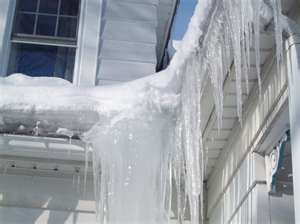Does Ice Dams Cause Damage to the Roof or Shingles?
 With winter on its way, many homeowners are concerned about the effects snow and ice can have on their home, especially their roof. Can snow damage a roof and shingles? The answer, unfortunately, is yes. Every year, snow build-up on roofs is a major cause of damage to both the shingles and to the roof deck underneath. This Roofing Tutor article looks at causes and concerns of ice dams and snow.
With winter on its way, many homeowners are concerned about the effects snow and ice can have on their home, especially their roof. Can snow damage a roof and shingles? The answer, unfortunately, is yes. Every year, snow build-up on roofs is a major cause of damage to both the shingles and to the roof deck underneath. This Roofing Tutor article looks at causes and concerns of ice dams and snow.
Ice Dams
Ice dams are the single largest cause of snow damage to roofs and shingles. If you aren’t familiar with an ice dam, here’s a brief explanation.
An ice dam begins when heat escapes from a home through its roof. The heat causes snow against the roof to melt. If the temperature outside is above freezing, the water will simply drain off the roof. However, if the air temperature is below freezing as is often the case in colder climates, the water will run down the roof until it reaches the unheated part of the roof, the overhang over the eaves. When it reaches this part of the roof, it will freeze. Eventually, a dam of ice will form near the low edge of the roof.
As water continues to melt, it will run down the slope until it reaches the eaves. With nowhere to go, it will often be forced to back up under the shingles. When this happens, it can damage the shingles, especially if it freezes there when the temperature drops even further. Old, brittle shingles are easily damaged by the freezing action of water.
In addition, the water under the shingles reaches the wood roof deck. It will soak the wood, eventually causing rot and warping. It may also seep through joints in the roof deck and run directly into your attic. There, it can ruin insulation, wet roof trusses and cause rot, present mold issues, and even damage drywall and other parts of your home.
Other Types of Snow Damage
If roof shingles have been blown off in a windstorm or damaged in a hail storm or other event, then melting snow can leak into the roof and cause the same types of damage that an ice dam can cause. If you have a severe windstorm or hailstorm, be sure to check your roof for damage before the snow starts to fall.
In some areas, large amounts of very wet snow can threaten a roof as well. In most northern climates, roofs must be built to stronger standards than in some places. Still, older roofs have been known to give way under the weight of very heavy snow that is already wet or that gets rained on in subsequent storms. Collapsing roofs are more common with barns and pole buildings, but it does happen with homes occasionally.
Preventing Damage to Your Shingles or Roof Caused by Snow and Ice
The first thing you should do to protect your roof is to have it inspected by a roofer before winter, especially if it is more than 10 years old. That way, needed repairs can be made before the roof is covered with snow. If you decide to do the inspection yourself, be sure to practice safety, whether you inspect the roof from an attic or get up onto the roof. Secondly, consider adding insulation to your attic in order to prevent the heat loss that leads to ice dams. Finally, there are a few products you can add to your roof to prevent ice dams but they vary in quality and effectiveness. Ask your roofing specialist for suggestions.
